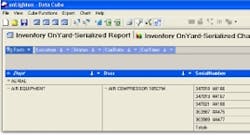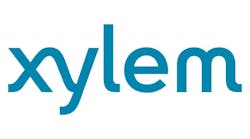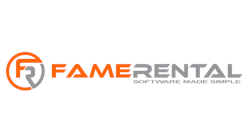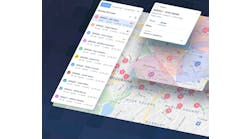Rental Business Following the Mobile Revolution
Interview participants
Jason Albus, systems engineer, Point of Rental Systems
J.J. Shea, general manager, Solutions by Computer
Michael Saint, president, Corporate Services
Paul Chapdelaine, president and founder, RMI Corp.
Richard Hercus, director of sales, Enterprise Solutions Americas, Ramco
Ray Bonestroo, president, Genisys Software
Michael Stilwagner, vice president of business development, Wynne Systems
Olly Williamson, vice president, inspHire Inc.
John Bertolino, director of sales, SYCOR Americas
Rob Ross, president, Alert Management Systems
RER: Last year we talked a lot about the gradual acceptance of cloud-based technology by the rental industry. What has changed over the past year in terms of the industry's attitude about storing business information in the cloud?
Albus: Rental owners are still weighing the cost benefit of cloud-based versus traditional servers. The cloud certainly pays off when a company can eliminate IT staffing and resources, but most rental stores do not even have dedicated IT staff. Most cloud hosting providers' fees are the equivalent of buying a traditional server every year. From that perspective, it can be a tough sell. Although Point-of-Rental software can support cloud-based installations, we recommend using the cloud to augment the traditional server in the form of cloud-based backups and email services. Allocating specific facets of IT to the cloud delivers a better ROI versus simply throwing everything into the cloud.
Shea: To some degree, business use of the cloud is being driven by consumer behavior. That's where the familiarity starts. In the past year, companies in all industries have become more interested in storing information in the cloud. The mystique is being replaced with an appreciation for the advantages of cloud technology. The benefits include reduced staffing, greater efficiency and the aggregation of many different functions delivered through one source.
For a rental business, that can mean contract processing, operations management, dispatching, data vaulting, reporting and numerous other capabilities, all hosted in the cloud.
Saint: Most of our customers are large enough that they already have an IT department and large infrastructure. After investigating the total cost of a cloud-based solution, they have concluded that for them it was not a cost-effective solution. They do see some benefits. We only have a dozen or so clients running in the cloud and they seem satisfied. It is cost effective for them because it eliminates the cost of owning and maintaining equipment.
Chapdelaine: How many rental companies can truly state that their entire systems are being backed up each and every day and that the backup is being stored at a secure off-site facility? Not as many as they themselves may think!
The rental industry is quickly coming to the realization that important information is actually much more secure in a cloud environment than it ever was in their on-premise world. This is so because of the professional nature in which data is stored and secured within the cloud world.
Hercus: The rental industry has started to recognize the logistic and economic benefits of cloud technology. Cloud computing provides a more effective and simplified way of running processes at a fraction of the original cost. Companies who ignore the benefits of cloud computing are taking a risk. A recent study published in Forbes magazine indicates that 50 percent of its respondents now say that they have “complete confidence” in the cloud — up from only 13 percent of respondents a year ago. This increasing support of cloud-based solutions for managing business is also evident within the rental industry.
Bonestroo: It seems to have gained in acceptance, because of companies like QuickBooks offering their products in a cloud-based environment. There does seem to be a reluctance of the hosting companies to give up the data once they have it, as we have converted rental companies from this type of service back to a server-based model so they could have control of the data, increased speed and not have to be reliant on intermittent Internet speeds and connections.
Stilwagner: Over the past year, we have seen the rental industry overcome most reservations it previously had about cloud computing. Data being stored in the cloud has proved to be just as safe as when it is hosted on a company-owned server. With security not being in question and the lower cost of having a cloud-based solution, we have seen a shift from it being an offering considered mostly by smaller companies to a solution even large corporations with hundreds of locations are opting for.
Bertolino: Cloud-based technology is great as a middleware communication application, but it does not replace a fully integrated ERP system.
Ross: We are seeing increasing acceptance of secure cloud storage, with appropriate encryption, PCI-compliance (for credit card processing over the cloud), and other safeguards. With regard to retail back-up services, such as Carbonite, Mosy, and Barracuda, our customers are recognizing the need for Emergency Restore service, not just for back-up. Our own private-label back-up service provides an emergency guarantee and assures rapid restoration in the event of a system failure.
RER: Has the growth of Software as a Service rental management models outpaced traditional rental management software computing models? Have there been any surprise benefits that users didn't expect?
Albus: SaaS has not taken the lead. The benefits are similar to the cloud concept, however so are the limitations. With SaaS you are essentially in a perpetual rental. One surprise we have heard from a new customer was their difficulty in obtaining their data from their former SaaS provider. A rental owner who wants to change software vendors is at the mercy of the SaaS provider to hand over the rental store's data to be converted. It is very important to know those details up front. Point-of-Rental's position is the data belongs to our customer, and we will always deliver it if they ever need it.
Shea: I wouldn't say that SaaS has outpaced traditional computerization models, but it's certainly growing at a fast pace. That's not surprising when you consider that it dramatically reduces upfront costs, eliminates the need for system management, and harnesses the Internet for seamless access and automatic functions like offsite backups. On top of that, SaaS means the rental business always has the latest software release.
We've seen SaaS adopted by rental businesses at different times for different reasons. One driver is the upgrade cycle. When a server ages, and it comes time for an upgrade, we've had a number of customers opt for our SaaS models: CProRent and EnfinitySaas.
A far less frequent but more intense driver is a server failure. When one of our users has a catastrophic server failure from natural disaster, over-aged hardware or other reason, we've been able to restore the online database backup immediately to a SaaS server.
Chapdelaine: This is RMI's fifth year of offering its ADVANTAGE Solution via the Cloud. In the past 12 months we have experienced 100-percent growth in both the number of companies and the number of users that are subscribing to our solution. Customer and User additions are outpacing our best years of on-premise licensing.
Bonestroo: We haven't seen growth yet in this area. We are doing vastly more implementations using the server-based model.
Stilwagner: From our experience, the SaaS rental management model has outpaced traditional rental management software computing models. Clients realize that hosted solutions remove the need for an IT staff, the cost of ownership from servers, backup systems and related software.
RER: The adoption of doing business using smaller devices such as smart phones and tablets when away from the office has been fast. Would you say this is true for the rental industry? Does your company offer software compatible for use from mobile devices?
Albus: Yes, just take a look around at The Rental Show and you will see everyone staring at their mobile devices. Point-of-Rental's entire software suite is compatible with mobile devices like iOS, Android and Windows. Rental owners can do everything just like they were in the store — see all reservations and open contracts, write new contracts, check availability of an item, or look at their corporate dashboard to see how the overall business is doing from their mobile device.
The rental store's customers can view the inventory, safety documents, invoices, statements, and they can also rent equipment on their mobile device. Our integrated web design service, which uploads daily inventory from the store's Point-of-Rental System, is even optimized for use on mobile devices.
Shea: In our experience, hand-held and tablet devices represent one of the strongest emerging trends in rental business management. Rental operators can use tablets to access our software remotely over the Internet. We can also connect our system users with their end-customers through an e-portal. Their customers use mobile devices to access real-time information through the e-portal and manage their accounts online.
One prolific use of our software is the Email Updates function — automatic emails generated by Enfinity or CounterPro that notify rental operators when specific circumstances occur. These could be delinquencies resulting in overbooking, wait-listed items coming available, risk alarms or quotation follow-ups. The rental business can specify who gets each type of notification, so the right people are managing the business even when they're on the road.
Saint: We have seen increased acceptance with the tablet devices because the screen sizes allow much more information on a single screen. Our offerings include applications to create rental orders, to return items from rental; to count and relocate inventory; to update repair information; and more.
Chapdelaine: RMI's Mobile User offering is generating a lot of benefit to our users — not the least of which is the lower cost associated with it. Let's face it, mobile users such as field service and sales people and, even inside workers that have somewhat limited needs for access to the system, do not need access to the entire system. What they do need is the ability to check on the status of things and update information based upon what they are currently doing with a customer.
Hercus: This has become the necessary norm for the industry. Rental companies need to be able to transact their business using smart phones and iPads/tablets. The sales force in the field needs to check equipment availability, possibly create reservations and allocate inventory. Senior managers benefit from real-time performance information and alerts.
We offer the entire Ramco solution on an iPad. Ramco Rental Solution delivers graphical dashboard portlets on the iPad, allowing the user to monitor key performance metrics such as utilization, profitability, revenue and more.
Stilwagner: In order to stay current, the rental industry had to adopt business models to fit the smart phone and tablet boom. The goal of our Axiom Mobile Solution is to offer functionality included in our AXIOM ERP, formerly RentalMan, product relevant to field sales and technicians.
Williamson: inspHire has a variety of options for providing the power of inspHire in the palm of your hand, from sales and management aids through our inspHire iX solution, designed in HTML5 for the newer smart phone/tablet devices, to our operational inspHire Mobile Working functionality.
Bertolino: Yes the adaptation of web-based tablets and PDA's has grown at a very fast rate. Since the SYCOR solution is a fully integrated ERP system designed in open architecture platform it is fully compatible with these types of devices.
Ross: Our main application, Alert EasyPro, is written in a way that translates well into the smaller screen world. For example, our customers can use Remote Desktop Protocol (RDP) to hook up multiple devices without extra licensing fees or costly products from us. We have also begun to develop a comprehensive suite of low-cost software that is optimized for small-screen display and is web-based — all you need is a web browser to run directly from an iPhone.
RER: How has the growth of mobile device usage and access to real-time business information changed the expectations of your rental software customers? What do you focus on when developing the next product to stay ahead of those customer expectations?
Shea: It's mostly a case of developing remote capabilities and making sure that they're rental-savvy and easy to use. Our customers expect tools and data to become mobile these days because their own customers expect the same thing. We put ourselves in the mindset of the rental operator when he's out on a jobsite or researching a bid, at home catching up on reports or pitching new business. Our development agenda works backwards from our users' needs.
Saint: Our clients expect that remote data solutions exist whether web based or mobile based, but very few have adapted them as primary solutions. As expressed by one client, “I use the email on my phone to be notified, but unless it is an emergency, I prefer to respond when I am at my desk.”
Our software solutions are in a constant state of development responding to both client requests and technology updates. We see this as an evolutionary process rather than a product solution. Once a client purchases one of our solutions, they never buy it again; they simply maintain it by installing updates.
Chapdelaine: Our customers are quickly seeing the advantages that 24/7 connectivity delivers. A simple thing like “Sign and Send” that is available on most devices means that customer-facing paperwork is now completely electronic and virtually instant. In addition, signed documents are being stored immediately right within the system.
Stilwagner: The growth of mobile device usage pressured rental software companies to create offerings that would give their clients information when and where they wanted it. Our focus includes not only providing a stable and secure product, but one that can be easily implemented on various devices.
Williamson: The past 12 months have definitely seen an increase in the demand for mobile access to data both by our customers, and their customers. As most people have now embraced having 24/7 access to their email and the Internet, getting access to their software is following quickly. We have improved both our inspHire iX, and Mobile Working over the past 12 months and we are listening to our customers on where to focus our mobile app development in the future. Not surprisingly, the more people become used to working with mobile apps and the simplicity of the user interface, the more customers focus on the core rental application having similar levels of easy-to-use screens and features.
RER: What are the very latest trends in rental management software technology? What's next?
Shea: The first two decades of rental computerization were largely about data capture. Then the focus shifted to data mining — finding ways to do more with the data that is captured by the system.
Our Enlighten software was designed to excel at data mining. Enlighten allows the rental operator to extract data and manipulate it in customized ways by using queries. We recently expanded our Enlighten library to include some very specific queries that empower rental business management, like potential income projections, tax audit information and inventory on-yard.
Saint: Integration with external products remains the most significant request that we receive. There are so many specialty applications available to our clients to expand their capabilities. These range from ERP and accounting software packages, GPS monitoring, routing, “sales tax” services, and more.
Secondly, some of our clients are moving into the global marketplace, so a lot of our work is related to offering multi-currency and localized languages so that our clients are not restricted to English-speaking customers.
The third area of increased utilization has been reports and dashboards. Our clients seem to have a thirst for knowledge regarding their business, so we are developing more tools and reports for our clients.
Chapdelaine: The cloud, mobile devices and KPI reporting are the three hottest things in the industry right now. In addition, we are seeing significant traction in the area of Web portal where rental business customers can go to self service.
Self Service is somewhat generational where older customers may not be willing to use it while younger customers not only expect it, they demand it.
Stilwagner: Aside from mobile solutions, we think the next trend will be toward fully contained systems. Most companies use third-party systems, which often require further development due to custom links and/or logic. Our product, AXIOM Integration Architecture, uses web services to allow outside applications direct access to business process logic contained with our AXIOM ERP solution. We know this will be the next step for our clients to take advantage of third-party applications for credit checking, sales for automation and intelligent parts procurement.
Williamson: As the economy is getting back on its feet and companies are getting busier, owners and managers want to get good, solid access to their management data. inspHire has been increasing the number of reports in the core software, as well as developing a new management dashboard to help to give customers better, real-time access to key information. The trend is that this will continue as companies try to maximize profitability whilst also getting the most out of their inventory.
Continue to page 2






